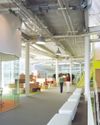With technology derived from watchmaking, Vitrocsa’s structural glass systems help architects inch closer to the Modernist vision of invisible walls.

Swiss entrepreneur Eric Joray had never seen Pierre Koenig’s Stahl House in person, but its image was firmly planted in his imagination. With its transparent floor-to ceiling walls, it represented the paradigm of lightness that Southern California’s airy Modernism seemed to embody—although not without its drawbacks. “Don’t build a glass house if you’re worried about saving money on heating,” Philip Johnson, creator of perhaps the most iconic glass house of all, famously said.
In 1993, wanting to re-create California Modernism in the vastly different climate of his native Switzerland, Joray launched Vitrocsa, a glass curtain wall system that has become a favorite among high-profile architects for luxury residential projects, including forthcoming Manhattan high rises by David Chipperfield, Isay Weinfeld, and Richard Meier. His goal had been both to realize the Modernist ideals of dissolving barriers between interior and exterior, and to provide thorough protection against the elements.
“Those single-glazed sliding doors— there’s no way they could do that in Switzerland,” says Vitrocsa USA CEO James Tschortner, who cofounded the company’s American headquarters in Los Angeles in 2009 (and took Joray to finally see the Stahl House in 2013). Midcentury glass houses were notoriously fragile, unsafe, and ill suited for climate control. But as a former maker of luxury Swiss watch components as well as an avid orchid cultivator, Joray combined his expertise in both high-precision manufacturing and greenhouses to create a new dual-glazing method that would surmount these obstacles. Floating the glass to cool on a bath of molten tin, for example, relieves it of its internal tensions and gives it greater resilience.
Diese Geschichte stammt aus der October 2016-Ausgabe von Metropolis Magazine.
Starten Sie Ihre 7-tägige kostenlose Testversion von Magzter GOLD, um auf Tausende kuratierte Premium-Storys sowie über 8.000 Zeitschriften und Zeitungen zuzugreifen.
Bereits Abonnent ? Anmelden
Diese Geschichte stammt aus der October 2016-Ausgabe von Metropolis Magazine.
Starten Sie Ihre 7-tägige kostenlose Testversion von Magzter GOLD, um auf Tausende kuratierte Premium-Storys sowie über 8.000 Zeitschriften und Zeitungen zuzugreifen.
Bereits Abonnent? Anmelden

No New Buildings
The energy already embodied in the built environment is a precious unnatural resource. It’s time to start treating it like one.

The Circular Office
Major manufacturers are exploring every avenue to close the loop on workplace furniture.

Building for Tomorrow, Today
Radical change in the building industry is desperately needed. And it cannot happen without the building trades.

Strength from Within
Maggie’s Centres, the service-focused cancer support network, eschews clinical design to arm patients in their fight for life.

Next-Level Living
The availability of attractive, hospitality-grade products on the market means everyday consumers can live the high life at home.

Enter The Culinarium
AvroKO imagines the future of residential amenities—where convenience, comfort, and sustainability meet.

Science Says Light Brighter!
In Troy, New York, a leading research center studies the connection between light, color, and well-being.

A New System Aims To Activate Outdoor Space
Emphasizing modularity and customizability, a new system aims to activate outdoor space.

Metropolis Thinktank
Autonomous in Chicago

Spectrum
An essential survey of architecture and design today